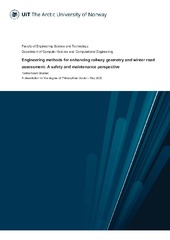| dc.contributor.advisor | Bordin, Chiara | |
| dc.contributor.advisor | Mishra, Sambeet | |
| dc.contributor.author | Isaksen, Ole-André | |
| dc.date.accessioned | 2023-08-23T09:25:33Z | |
| dc.date.available | 2023-08-23T09:25:33Z | |
| dc.date.issued | 2023-06-01 | |
| dc.description.abstract | For Norway to reach the emission limits in the Paris Agreement, a substantial amount of CO2 must be reduced. Road traffic alone accounts for a high percentage of the total emissions during 2021. This thesis will focus on electrifying the transport sector and analyzing charging infrastructure for heavy-duty electric vehicles. New charging infrastructure for heavy-duty Electric Vehicles (EVs) provides issues regarding profitability due to the currently low adaption rates. However, heavy-duty EVs use the same charging sockets as EVs. As a result, EVs may finance the charging infrastructure needed to increase the adaption of heavy-duty EVs. Projections from Norwegian grid operators suggest that the total electricity surplus is diminishing during the next years and will be negative by 2027. This highlights the importance of modeling the power system in combination with finding optimal locations for charging stations. This study uses prescriptive analytics to suggest optimal locations for charging infrastructure to maximize returned profits to motivate station builders to implement more charging stations. A soft-linking will be done with PyPSA-eur to model the power system, where the new infrastructure is added as an additional load. Analyzing the results, it is possible to see that charging infrastructure has the potential to become profitable as the adaption rate for heavy-duty EVs rise. The collaboration between the models offers an open-source tool for scholars, researchers, and planners to study how new charging infrastructure affects key components in the Norwegian power system and could be useful in modeling state-of-the-art technologies. | en_US |
| dc.identifier.uri | https://hdl.handle.net/10037/30230 | |
| dc.language.iso | eng | en_US |
| dc.publisher | UiT The Arctic University of Norway | en_US |
| dc.publisher | UiT Norges arktiske universitet | en_US |
| dc.rights.accessRights | openAccess | en_US |
| dc.rights.holder | Copyright 2023 The Author(s) | |
| dc.rights.uri | https://creativecommons.org/licenses/by-nc-sa/4.0 | en_US |
| dc.rights | Attribution-NonCommercial-ShareAlike 4.0 International (CC BY-NC-SA 4.0) | en_US |
| dc.subject.courseID | EOM-3901 | |
| dc.subject | VDP::Teknologi: 500::Informasjons- og kommunikasjonsteknologi: 550::Geografiske informasjonssystemer: 555 | en_US |
| dc.subject | GIS | en_US |
| dc.subject | VDP::Matematikk og Naturvitenskap: 400::Matematikk: 410::Analyse: 411 | en_US |
| dc.subject | Prescriptive analytics | en_US |
| dc.subject | VDP::Matematikk og Naturvitenskap: 400::Matematikk: 410::Analyse: 411 | en_US |
| dc.subject | Optimization | en_US |
| dc.subject | VDP::Matematikk og Naturvitenskap: 400::Fysikk: 430::Elektronikk: 435 | en_US |
| dc.subject | Electric Vehicle | en_US |
| dc.subject | VDP::Matematikk og Naturvitenskap: 400::Fysikk: 430::Elektronikk: 435 | en_US |
| dc.subject | Power systems | en_US |
| dc.title | Optimal sizing and placement of Electrical Vehicle charging stations to serve Battery Electric Trucks | en_US |
| dc.type | Master thesis | en_US |
| dc.type | Mastergradsoppgave | en_US |


 English
English norsk
norsk



